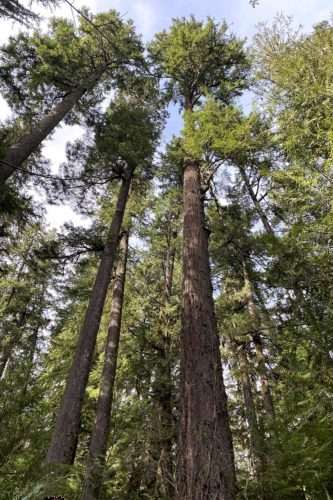
Quick, what’s the closest old-growth forest to Eugene? The Delta Old-Growth Grove on the McKenzie River? Nope — those trees burned in 2020, and they weren’t all that close to town.
If you want to impress out-of-state visitors with giant trees — or if you just need to hug something really ancient — hike a 1-mile loop through the McGowan Creek Environmental Education Area, a little-known grove in the Coburg Hills near Mohawk.
Eugene-area science teachers have been taking busloads of schoolchildren to this forest hideaway for more than 20 years. It’s a great hike for kids. Because it’s only 10 miles from Springfield you could even bicycle there. The route to the trailhead is entirely paved.
Douglas-firs along the trail are nearly 7 feet in diameter and up to 250 feet tall. School classes come here not just to ogle big trees, but also to identify native plants, balance across a 120-foot single-log bridge, and examine pond insects in a cattail swamp. There are gazebos with picnic tables. Trilliums bloom in spring and vine maple leaves turn into scarlet pinwheels each fall. Moss is everywhere.
The reason more hikers haven’t discovered McGowan Creek is that there are no signs at the locked gate where you park. You have to walk an unmarked spur road half a mile to reach the actual trail. I suspect this is intentional, to hide the grove from the most frequent visitors to this part of the Coburg Hills: target-shooters. A gun club’s range is 2 miles away. Although I didn’t hear gunshots in the woods on my Saturday visit, dozens of “No Shooting” signs along the road suggest that spillover is a problem.
If you look at the Coburg Hills with Google Earth, you’ll see a weird checkerboard of one-mile squares, alternating green and brown. This is a legacy of the Oregon & California railroad scheme. In 1866, Congress gave a 40-mile-wide swath of alternating square miles to a private company as an incentive to build a rail line between the two states.
Today the brown squares are mostly private timber company lands, logged every 30 years or so. The rest of the O&C checkerboard belongs to the public, managed by the Bureau of Land Management. The BLM logs less frequently, and in the case of McGowan Creek, has preserved an overlooked grove intact.
To drive here, take I-105 (Hwy 126) east from I-5 for 4 miles to Springfield’s 42nd Street exit. Turn left on 42nd for half a mile to a T-shaped junction and turn right on Marcola Road. After another 6.2 miles turn left on Hill Road for 0.1 miles to the Mohawk General Store.
Stop at this old-timey store before or after your hike — not because the wrapped sandwiches are particularly good, but because the place dates to the early 1900s, with creaking wooden floorboards of old-growth fir. A bench out front with artwork by Eugene sculptor Ellen Tykeson honors David Schuman, the late deputy Oregon attorney general who loved to bicycle here from Eugene.
At the Mohawk store turn right onto Donna Road for 0.6 miles. Then turn uphill to the left onto one-lane McGowan Creek Road for 3.5 miles to a fork. Park on the left, just after a milepost marked “3.5.” Then walk down the left-hand fork of the road, past a locked yellow gate marked “No Shooting.” A small sign may identify this oiled gravel spur as Road 16-2-20.
After walking the logging road for 0.5 miles, you will finally be rewarded with an actual trailhead sign. Walk straight past a kiosk to a T-shaped trail junction. For the 1-mile loop, follow a “Tall Trees Loop” pointer to the left. Keep left at all junctions from then on. You may have to step over a fallen log here and there, but you won’t get lost, even if you’re staring up at the tall trees, limbless almost to the distant sky.
The entire hike only takes an hour. The drive is short, rural and pleasant. But that’s the point. Where else can you visit an old-growth forest this close to Eugene?
William L. Sulllivan is the author of 23 books, including The Ship in the Woods and the updated 100 Hikes series for Oregon. Learn more at OregonHiking.com.
